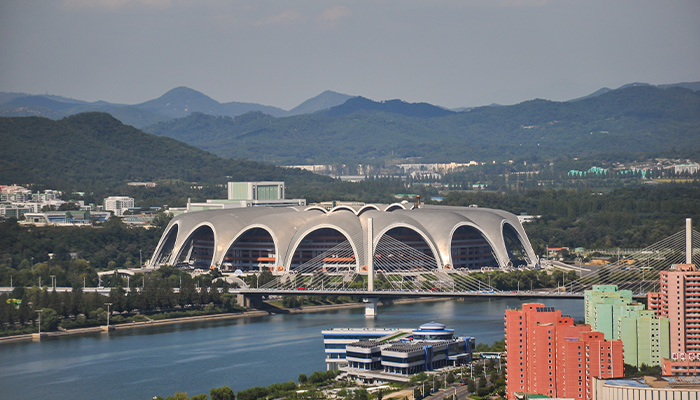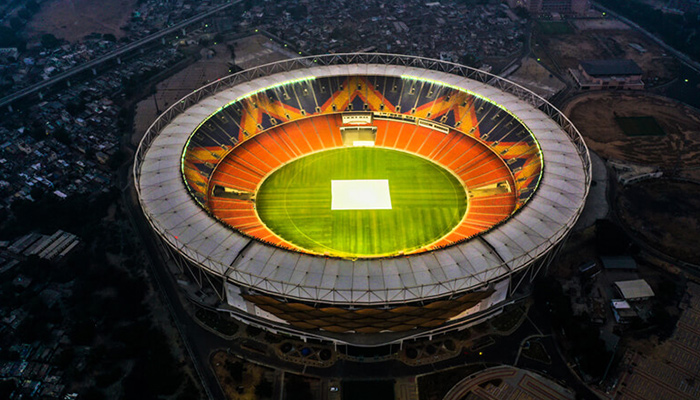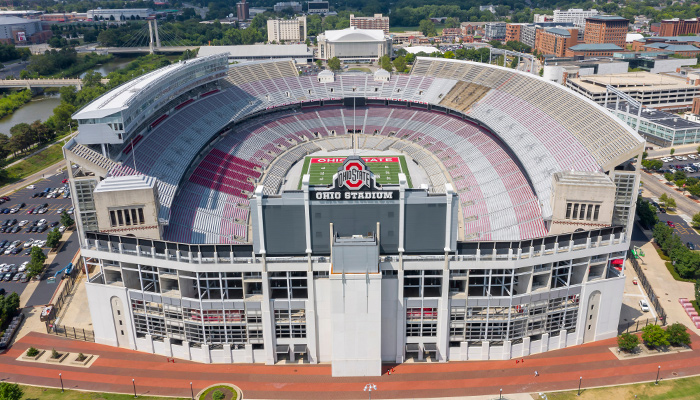Taking a Look at the World’s Biggest Stadium

- The World’s Biggest Stadium
- A Breakdown of Other Large Stadiums
- A Surprise #1 Entry
- India’s Narendra Takes 2nd Place
- Over to the USA For #3
- Another US Stadium
- And Another US Entry…
- Other Notable Large Stadiums
The world’s biggest stadium will surprise you – and no, it’s not located in the USA, Europe – or even South America! On this page, we’re going to be showing you the largest stadiums in the world – and we’ll also be giving you some basic background information on these stadiums. We’ll also look at some of the world’s other stadiums that are capable of fitting more than 100,000 people!
What Is The World’s Biggest Stadium?
The largest sports stadium in the world is, surprisingly, located in North Korea! It’s called the Rungrado 1st of May Stadium, and it’s located in the hermit country’s capital city, Pyongyang. Home to the Korea DPR national football team, the stadium is capable of seating a huge 114,000 fans – and there are even expansion plans in the pipeline! Let’s find out more about it, and other huge stadiums around the world.
Largest Stadiums in The World
Today, there are a total of 11 stadiums around the world that are capable of seating over 100,000 spectators. A lot of these are located in the USA – but other countries like India and North Korea are also home to these monster sports complexes. Below, we’ll look at the five biggest stadiums in the world.
The sports played at these stadiums varies – usually, depending on the country that they’re located in. The USA, for example, usually sees NFL games played – as soccer is far less popular in the States than in other countries. Other countries, like India, generally host cricket in their largest stadiums – while European and South American stadiums are usually used for soccer.
Rungrado May Day Stadium
The Rungrado May Day Stadium in Pyongyang, North Korea, is a vast sports facility. It is not just the world’s largest stadium by seating capacity, but also by overall capacity, with a huge 114,000 people able to fit inside – although many more are reported to be admitted, raising the capacity even further. It was constructed in 1989 and has hosted a variety of athletic events, concerts, and other cultural events since then.
The stadium is designed in the style of a flower, with seats placed in levels around a central pitch. With the levels rising up and apparently infinite rows of chairs reaching out in every direction, it’s a truly stunning sight to witness. Even if you’re not very interested in sports, it’s a must-see if you’re ever in Pyongyang.
Aside from its vast size, the Rungrado May Day Stadium is also noted for its distinctive architecture and cutting-edge facilities. The movable roof is a nice feature, and the playing field is composed of synthetic turf, which is considerably more durable and easier to maintain than natural grass.
There are also several spectator conveniences, including food and beverage stalls, bathrooms, and even a small medical center.
Unfortunately, unless you’re able to travel to North Korea, your chances of ever actually seeing this stadium are slim; however, some foreigners have been there, so it’s not completely out of the question!
Narendra Modi Stadium
The Narendra Modi Stadium is an Indian sports complex in Ahmedabad, Gujarat. It has a seating capacity of roughly 135,000 people and is a popular arena for a variety of athletic activities like cricket, soccer, and hockey. The reason this stadium isn’t listed above North Korea’s Rungrado stadium is because the DPRK are believed to pack even more spectators in than the officially listed capacity.
The Narendra Stadium was erected in 1982 and has subsequently undergone various repairs and additions to better serve modern athletes and spectators. Its well-kept playing field and cutting-edge training facilities make it a popular choice for both local and national athletic events.

In addition to its athletic facilities, the Narendra Modi Stadium has a variety of spectator services like food and beverage outlets, bathrooms, and shaded seating places. It’s a terrific area to hang out with friends and family on a hot afternoon while watching a sporting event.
One feature that distinguishes the Narendra Modi Stadium from other sports facilities is its central position in Ahmedabad. It is easily accessible by public transport and is surrounded by a variety of hotels, restaurants, and other attractions, making it a pleasant and entertaining destination to visit.
Michigan Stadium
Michigan Stadium, nicknamed “The Big House,” is a collegiate football stadium in Ann Arbor, Michigan. With a seating capacity of nearly 107,000 people, it is the largest stadium in the United States and the second largest in the world. It has been the home of the University of Michigan Wolverines football team since it opened in 1927.
The huge size and famous “winged” architecture of Michigan Stadium has made it a popular venue for a variety of athletic events and concerts throughout the years. With rows and rows of seating reaching out in every direction and the team’s trademark blue and yellow colors covering the bleachers, it’s a stunning sight to witness.
In addition to its athletic facilities, the Michigan Stadium offers a variety of spectator amenities. It’s a terrific area to hang out with friends and family on a hot afternoon while watching a football game.
One feature that distinguishes Michigan Stadium from other sports facilities is its placement on the University of Michigan campus. It is bordered by other sporting facilities, restaurants, stores, and other attractions, offering everything visitors could want.
Beaver Stadium
Pennsylvania’s Beaver Stadium is a collegiate football stadium. With a seating capacity of nearly 106,000 people, it is the second biggest stadium in the United States. It has been the home of the Penn State Nittany Lions football team since it opened in 1960.
It was designed by architects Hazlett, Clancy and Associates and built for $1.5 million by the E.T. MacKenzie Company.
The stadium was initially built to hold 46,000 people, however it has been expanded multiple times throughout the years to accommodate more people. The first extension, completed in 1978, provided 20,000 more seats.
The Beaver Stadium is recognized for its vast dimensions and rowdy atmosphere, making it a difficult venue to play for rival teams. With rows and rows of seating reaching out in every direction and the team’s signature blue and white colors covering the bleachers, it’s a daunting sight to see for an opposition team.
Ohio Stadium
Ohio Stadium, also known as the Horseshoe or The Shoe, is the home stadium of the Ohio State Buckeyes football team. It is located on the campus of Ohio State University in Columbus, Ohio. The stadium has a seating capacity of over 102,000, making it one of the largest football stadiums in the country.
The history of Ohio Stadium dates back to 1922, when the university broke ground on the new facility. The stadium was designed by architect Howard Dwight Smith and was completed in 1922. It was originally named Ohio Field, but was renamed Ohio Stadium in 1923.

Over the years, Ohio Stadium has undergone several renovations and expansions to keep up with the growing demand for tickets. The most recent renovation, which was completed in 2014, included the addition of a new two-story press box and luxury suites, as well as the expansion of the seating capacity.
In addition to hosting Ohio State football games, Ohio Stadium has also hosted a number of other events, including concerts, graduation ceremonies, and other sporting events. The stadium is known for its electric atmosphere on game days, with the Ohio State marching band and cheerleaders leading the crowd in cheers and song.
Ohio Stadium is a beloved landmark on the Ohio State University campus and is an integral part of Buckeye football culture. It is a must-see for any fan of college football and a truly iconic venue in the world of sports.
Other Notable Stadiums
The largest seating capacity stadium – and other notable contenders – have been listed on this page already. However, there are numerous other stadiums around the world that offer huge seating capacities – and below, we’re going to be taking a look at some of these stadiums, starting with the largest.
It’s notable that the vast majority of these stadiums are located in the US; however, when you start looking at stadiums with a seating capacity of less than 100,000, a lot of other countries start to appear, including Malaysia, Spain, Mexico, and South Africa.
| Stadium Name | Seating Capacity | Location |
|---|---|---|
| Kyle Field | 102,733 | USA |
| Tiger Stadium | 102,321 | USA |
| Neyland Stadium | 101,915 | USA |
| Darrell K Royal-Texas Memorial Stadium | 100,119 | USA |
| Bryant-Denny Stadium | 100,077 | USA |
| Melbourne Cricket Ground | 100,024 | Australia |